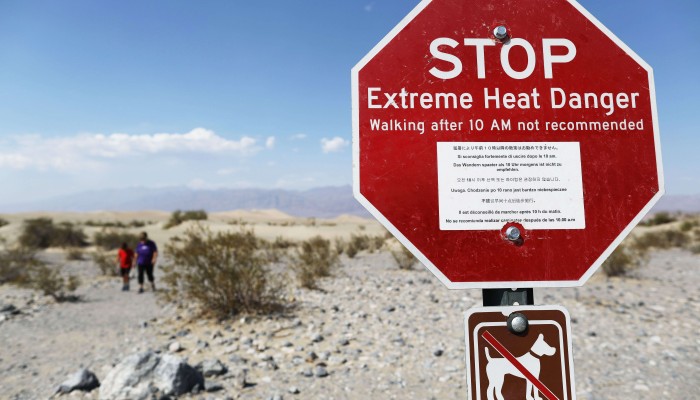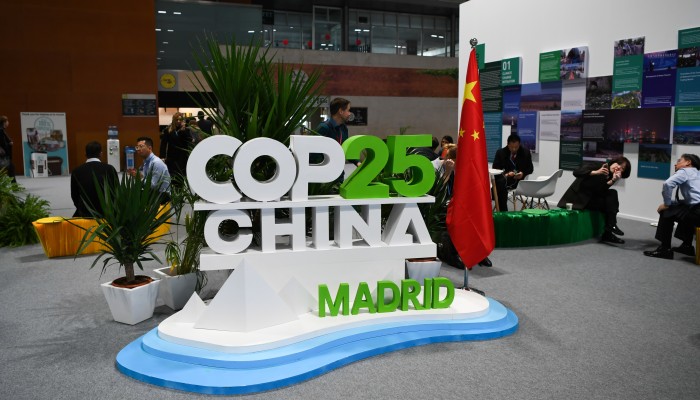Hello again,
In this edition of the South China Morning Post – Global Impact newsletter, we raise the question of whether the United States and China could cooperate on efforts to curb climate change and look at what China must do to meet its very ambitious goal to eliminate all carbon emissions by 2060.
John Carter
Senior Editor
Political EconomyCan the US and China revive their cooperation on climate change?
With US president-elect Joe Biden’s victory being confirmed on Wednesday, one major question comes to the fore: Will US-China relations continue to deteriorate or can the world’s two largest economies figure out a way to work together in some way?
Climate change policy may be the answer.
Biden has promised to bring the US back into the Paris Agreement on combating climate change after Donald Trump withdrew the US as one of his first actions as president. Biden has named a strong environmental team to back up that promise, with John Kerry, the former US secretary of state and presidential candidate, set to be his top climate envoy, someone the Chinese will take seriously.
This autumn, Chinese President Xi Jinping has promised to end all carbon emissions by 2060 and cut carbon dioxide emissions by at least 65 per cent by 2030, a mammoth task for the world’s top greenhouse gas emitter. There remain major doubts about China reaching these goals, given that the country is still building coal-fired power plants. Reaching the goal is estimated to cost US$15 trillion.
There is precedent for the US and China to cooperate on this issue. In 2014, under the Obama administration and while Kerry was secretary of state, the two countries reached an historic agreement to gradually scale back pollution. The deal was signed ahead of the Paris Agreement and made the global climate deal possible.Chinese Foreign Minister Wang Yi has already called on Biden to “restart dialogue” on a range of issues, particularly climate change.
China has a long way to go to meet its extremely ambitious target of cutting carbon emissions to zero by 2060 and getting more than halfway there by 2030. China must cut its reliance on fossil fuels to 25 per cent by 2050 from 85 per cent now. Some 90 per cent of Chinese industry will have to be retrofitted with carbon capture technologies, and all coal-fired power plants without such technology will have to be shut within 25 years to meet the zero emissions goal.
The country is participating in the global race to harness nuclear fusion to meet the energy needs without harmful emissions. China is also pushing ahead with development of hydrogen fuel cells for the nation’s large and growing vehicle fleet. Domestic companies need incentives and reforms to meet the government’s goal, given that their climate risk disclosures meet less than half international minimum standards.
To jump start the pollution reduction challenge, Beijing is opening its domestic energy sector to foreign investments to fund climate-saving technologies.
China is banking on market pricing of carbon emissions through a national emissions quota trading system to prompt companies to make necessary changes. In addition, the People’s Bank of China, the nation’s central bank, is pushing financial institutions to lend more for environmentally-friendly projects while supporting the increase in companies' "green bonds".
But in what may become a larger theme under the Biden administration, Chinese human rights issues are also affecting American’s ability to move toward renewable energy, particularly wind power, given that many of the wind turbines are made in Xinjiang province, amid allegations of forced labour there.
- South China Morning Post, SCMP -
Hello again,
In this edition of the South China Morning Post – Global Impact newsletter, we raise the question of whether the United States and China could cooperate on efforts to curb climate change and look at what China must do to meet its very ambitious goal to eliminate all carbon emissions by 2060.
John Carter
Senior Editor
Political EconomyCan the US and China revive their cooperation on climate change?
With US president-elect Joe Biden’s victory being confirmed on Wednesday, one major question comes to the fore: Will US-China relations continue to deteriorate or can the world’s two largest economies figure out a way to work together in some way?
Climate change policy may be the answer.
Biden has promised to bring the US back into the Paris Agreement on combating climate change after Donald Trump withdrew the US as one of his first actions as president. Biden has named a strong environmental team to back up that promise, with John Kerry, the former US secretary of state and presidential candidate, set to be his top climate envoy, someone the Chinese will take seriously.
This autumn, Chinese President Xi Jinping has promised to end all carbon emissions by 2060 and cut carbon dioxide emissions by at least 65 per cent by 2030, a mammoth task for the world’s top greenhouse gas emitter. There remain major doubts about China reaching these goals, given that the country is still building coal-fired power plants. Reaching the goal is estimated to cost US$15 trillion.
There is precedent for the US and China to cooperate on this issue. In 2014, under the Obama administration and while Kerry was secretary of state, the two countries reached an historic agreement to gradually scale back pollution. The deal was signed ahead of the Paris Agreement and made the global climate deal possible.Chinese Foreign Minister Wang Yi has already called on Biden to “restart dialogue” on a range of issues, particularly climate change.
China has a long way to go to meet its extremely ambitious target of cutting carbon emissions to zero by 2060 and getting more than halfway there by 2030. China must cut its reliance on fossil fuels to 25 per cent by 2050 from 85 per cent now. Some 90 per cent of Chinese industry will have to be retrofitted with carbon capture technologies, and all coal-fired power plants without such technology will have to be shut within 25 years to meet the zero emissions goal.
The country is participating in the global race to harness nuclear fusion to meet the energy needs without harmful emissions. China is also pushing ahead with development of hydrogen fuel cells for the nation’s large and growing vehicle fleet. Domestic companies need incentives and reforms to meet the government’s goal, given that their climate risk disclosures meet less than half international minimum standards.
To jump start the pollution reduction challenge, Beijing is opening its domestic energy sector to foreign investments to fund climate-saving technologies.
China is banking on market pricing of carbon emissions through a national emissions quota trading system to prompt companies to make necessary changes. In addition, the People’s Bank of China, the nation’s central bank, is pushing financial institutions to lend more for environmentally-friendly projects while supporting the increase in companies' "green bonds".
But in what may become a larger theme under the Biden administration, Chinese human rights issues are also affecting American’s ability to move toward renewable energy, particularly wind power, given that many of the wind turbines are made in Xinjiang province, amid allegations of forced labour there.
|
Was this newsletter forwarded to you? Subscribe here
|

|
|
|
|
|
9 January 2021 |
|
Hello again,
In this edition of the South China Morning Post – Global Impact newsletter, we raise the question of whether the United States and China could cooperate on efforts to curb climate change and look at what China must do to meet its very ambitious goal to eliminate all carbon emissions by 2060.
John Carter
Senior Editor
Political Economy
Can the US and China revive their cooperation on climate change?
With US president-elect Joe Biden’s victory being confirmed on Wednesday, one major question comes to the fore: Will US-China relations continue to deteriorate or can the world’s two largest economies figure out a way to work together in some way?
Climate change policy may be the answer.
Biden has promised to bring the US back into the Paris Agreement on combating climate change after Donald Trump withdrew the US as one of his first actions as president. Biden has named a strong environmental team to back up that promise, with John Kerry, the former US secretary of state and presidential candidate, set to be his top climate envoy, someone the Chinese will take seriously.
This autumn, Chinese President Xi Jinping has promised to end all carbon emissions by 2060 and cut carbon dioxide emissions by at least 65 per cent by 2030, a mammoth task for the world’s top greenhouse gas emitter. There remain major doubts about China reaching these goals, given that the country is still building coal-fired power plants. Reaching the goal is estimated to cost US$15 trillion.
There is precedent for the US and China to cooperate on this issue. In 2014, under the Obama administration and while Kerry was secretary of state, the two countries reached an historic agreement to gradually scale back pollution. The deal was signed ahead of the Paris Agreement and made the global climate deal possible.
Chinese Foreign Minister Wang Yi has already called on Biden to “restart dialogue” on a range of issues, particularly climate change.
China has a long way to go to meet its extremely ambitious target of cutting carbon emissions to zero by 2060 and getting more than halfway there by 2030. China must cut its reliance on fossil fuels to 25 per cent by 2050 from 85 per cent now. Some 90 per cent of Chinese industry will have to be retrofitted with carbon capture technologies, and all coal-fired power plants without such technology will have to be shut within 25 years to meet the zero emissions goal.
The country is participating in the global race to harness nuclear fusion to meet the energy needs without harmful emissions. China is also pushing ahead with development of hydrogen fuel cells for the nation’s large and growing vehicle fleet. Domestic companies need incentives and reforms to meet the government’s goal, given that their climate risk disclosures meet less than half international minimum standards.
To jump start the pollution reduction challenge, Beijing is opening its domestic energy sector to foreign investments to fund climate-saving technologies.
China is banking on market pricing of carbon emissions through a national emissions quota trading system to prompt companies to make necessary changes. In addition, the People’s Bank of China, the nation’s central bank, is pushing financial institutions to lend more for environmentally-friendly projects while supporting the increase in companies' "green bonds".
But in what may become a larger theme under the Biden administration, Chinese human rights issues are also affecting American’s ability to move toward renewable energy, particularly wind power, given that many of the wind turbines are made in Xinjiang province, amid allegations of forced labour there.
|
|
|
|
|
|

|
|
Will China’s new climate negotiator be a breath of fresh air?
|
| • |
Pollution control specialist is described as a practical, can-do figure but takes the helm at a moment of critical importance | | | • | Beijing’s role is likely to face intense scrutiny in coming year after failure of Madrid UN talks and warnings that temperatures are rising more quickly that previously forecast
|
|
|
China’s new chief climate negotiator Zhao Yingmin has taken on the role at a time when the country’s policies are likely to face intense scrutiny in the year ahead. The failure to reach agreement at the UN talks in Madrid this month is likely to heighten calls for someone to take the lead after the United States pulled out of a global agreement to limit emissions. Read more
|
|
|
|

|
|
|
|
|

|
|
China slow to curb coal financing as Japan, South Korea ‘accept new reality’
|
| • |
Japan and South Korea recently made moves to limit financial backing for overseas coal projects, joining a trend of banks and multilateral lenders ditching the fossil fuel | | | • | As the largest global financier of coal energy, China is increasingly looking like the lender of last resort
|
|
|
China risks being left behind as South Korea and Japan signal a shift away from financing overseas coal power in response to growing criticism over their support for the dirty fossil fuel. The three countries are the top global lenders for coal energy infrastructure, bankrolling projects beyond their borders through export credit agencies and developing new markets to export coal plant technology. Read more
|
|

|
|
|

|

|
|
EU proposes green alliance with US, signalling less reliance on China
|
| • |
Europe has grown wary of its dependence on China and will look elsewhere for a partner on clean and circular technology | | | • | The EU calls for joint action with the US to build relationships with democracies in the Indo-Pacific region
|
|
|
The European Union has proposed a “new green tech alliance” with Joe Biden’s incoming administration, amid mounting calls for Brussels to stop treating Beijing simply as a partner on climate change issues and also regard it as a competitor. The concept was included in a new transatlantic agenda put forth by European Commission president Ursula von der Leyen, which also proposes China should be the top geopolitical issue to be tackled jointly by Brussels and Washington. Read more
|
|

|
|
|
|
To keep track of the latest developments follow our daily coverage on our website or focus on development in climate change policy here.
In our next issue, we’ll examine the outlook for China’s Belt and Road Initiative given the changes caused by the coronavirus pandemic.
We’d welcome your feedback. Email me or tweet @scmpeconomy. Plus, be sure to check out our Economy news feed for the latest news and analysis.
All the best,
John
|

|
|
John Carter
Senior Editor, Political Economy
|
|
|
|
|
|
| SCMP NEWSLETTERS THAT MAY INTEREST YOU |

China at a Glance
A wealth of insights giving you the inside story on China every day.
China Economic Update
The latest developments from trade relations to growth rates and other key economic data.
Tech Wrap
The biggest tech news and reviews coming out of China, HK and Asia.
VIEW AND SIGN UP
|

|
|
|
Download our app
To get push notifications direct and never miss a story as it breaks
|
|
|
|
|
Hong Kong
China
Asia
World
Economy
Business
Tech
Comment
|
|
|
|
Copyright © 2021 South China Morning Post Publishers Ltd. All rights reserved.
|
|
This newsletter is created and catered for the global news reader. Each issue will feature a news story originating from China that carries a significant macro impact on the rest of the world.
We hope to share with you a broader perspective on the emerging topics shaping our world and that we feel are revolutionising the way we understand China.
|
















